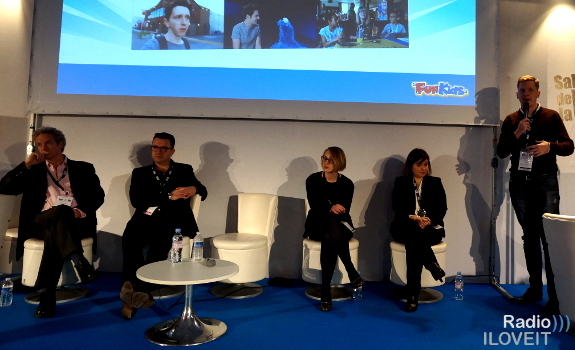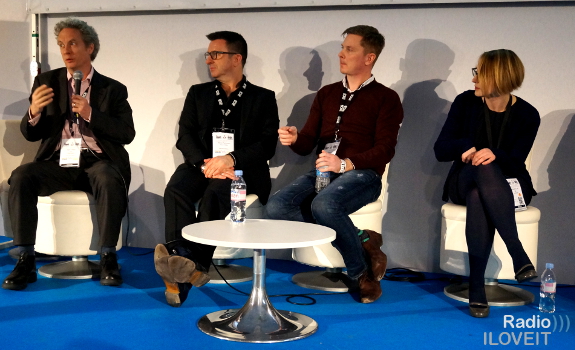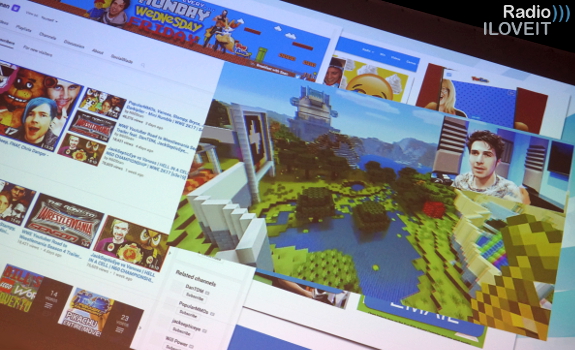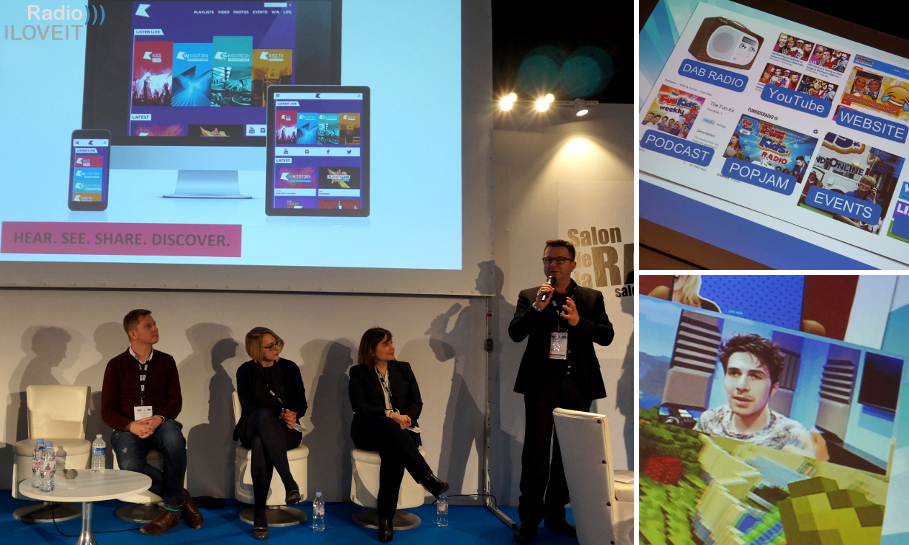For millennial audiences, broadcast radio might be not at the beginning, but at the end of the content funnel that will lead them to our medium over time.
The data presented in part 1 and part 2 of this article makes clear that there is a future for radio if we can reach millennials on other platforms than terrestrial broadcasting, using online spots for visual content to gather them, and direct them towards radio. At the Salon de la Radio 2017 in Paris, commercial and public radio operators from the UK shared how they are doing this in order to reach young people. One of them says: “we’re no longer a radio station”.
“They’re content driven, rather than platform driven”

Matt Deegan notes online platforms may help young listeners discover radio (image: Thomas Giger)
Mind your audience first
Bauer Media UK’s national radio director, Steve Parkinson, talked about how their KISS brand is targeting young listeners with a ‘see, hear, share, discover’ experience. The KISS Network, consisting of KISS, KISS FRESH and KISSTORY, is reaching about 5.5 million listeners (RAJAR, June 2016). “When we look across all of platforms, we have got 16 million connections”, he says about the reach of radio, TV, social media and live events combined. “We have 75 events a year. Our challenge as a commercial entity is: how do we market to 5.5 million, and how do we speak to the 16 million that are on many different platforms; realising they are consuming KISS not as a radio station, but as all of these media channels?”
Bauer Media has produced a ‘sizzle reel’ to remind advertisers in 90 seconds that KISS is a multimedia brand. “About four years ago, we said: we’re no longer a radio station.” He recalls that some advertisers, particularly agencies, found it a bit confusing: “They were buying radio [airtime] in an old-fashioned way, whereas if you’re Proctor & Gamble or an airline, you’re looking to see how you can get to the biggest audience more easily. Radio, commercially, has been forcing agencies to be more audience centric, rather than platform centric.”
Expand your millennial demographic
Targeting a generation glued to their mobile, KISS makes it a mission to be visual. “Our biggest investment over the last years has been to bring in cameramen and editors, and really visualise everything that we do.” The radio director makes a point when he adds that as radio broadcasters, we may spend too much time on millennials, and that another group may be even more relevant for radio stations targeting young listeners. “We have started to spend a lot more time looking at pre-millennials or Generation Z [to] dig a little bit deeper, and talk to the new generation; born after 2000. They have more concerns with terrorism, Trump, money worries, and relationship issues; they have almost double the concerns of millennials. We have to look at the next generation, so that radio, in an audio sense, will still be here in 2040-something.”
Sell your entire reach
Matt Deegan is in charge of a media brand for an even younger audience. Fun Kids is a radio station for 6-12 year-olds, which means that only the top end of their listener demo is measured by RAJAR’s diaries (10+). They also use TGI Target Group Index as a crossmedia research tool. It allows TV channels, web sites and radio stations to appear as a platform, so advertisers can decide on which platforms they’ll focus their budget. Fun Kids is broadcasting online, and on DAB across the UK. As their audience includes mostly listeners who are new to radio, it is essential to get their attention.
“We need to create an environment and a brand that really connects with their lives. Our audience doesn’t think about platforms at all; they think about content. They’re content driven, rather than platform driven. Most of our money comes from the radio, but teaching people that we exist encourages them to sample what we do. Often, the route to consuming the radio is through those other platforms.” Their main additional platforms besides digital radio are live events, as well as podcasts, YouTube and PopJam, and finally the station’s app, website and — surprising, considering the young audience demographic— email! (What about Facebook, Instagram and Snapchat?)
“I see no signs of them being digitally exhausted”

Mark Friend says young people are still avid consumers of (broadcast) media (image: Thomas Giger)
Take your personalities online
The UK’s children’s radio station has seen a lot of success with YouTube-specific content. “It’s not about having cameras in radio studios and filming an interview, but actually looking at YouTube as a particular platform with a particular audience, wanting to receive content in a specific way. We all know about the success of vloggers on the Internet, who create huge audiences. We try to reverse engineer that, and take some of our radio hosts to turn them into vloggers. They’re skilful already, and they can apply their skills to different platforms.”
He says that after BBC Radio 1 & 1Xtra, Capital and talkSPORT, Fun Kids is currently the 5th biggest UK radio station on YouTube. Breakfast show host Sean Thorn has got its own YouTube channel, where he covers a lot of games and books, and talks about his videos on the radio (instead of just the other way around). Videos are partly commercial, and partly content: “The advertiser wants those radio impacts, but also a direct connection with these YouTube audiences.” In his experience, most of their young audience is coming in through their YouTube channel, and then starts to listen to the radio, or to the podcasts.
Widen your platform scope
The public broadcaster’s youth brand, BBC Radio 1, also makes an effort to develop their YouTube presence. While the radio station is losing listeners, its video channel has now reached over 3.5 million followers and almost 1.2 billion views (source: Socialblade, May 2017). Mark Friend, Controller of the BBC Radio & Music Multiplatform division, explains that YouTube is an important part of the strategy, but not the only one; they have a multiplatform strategy. “We’re on the main platforms you’ll find our audience on, and you’ll also see us on the BBC platforms, like BBC iPlayer. We have a very good presence within the main televisual online products of the BBC as well. It’s good on the whole range of play consoles and digital TVs.”
Know your audience’s passion
With so many media, and so many platforms, are young people getting digitally exhausted, which may affect their radio consumption? Matt Deegan thinks we shouldn’t worry about it too much, because even if the listening time has dropped, the audience reach of 15-24s is overall remaining, as there is a lot for young listeners to hear on the radio, with Fun Kids, The Hits, KISS, Capital and Radio 1. Mark Friend agrees. “I have three children, aged 9, 14 and 15 — and I see no signs of them being digitally exhausted.”
The fact that some stations for younger audiences do have a program director who is in his 40s, should not be a problem either, as Steve Parkinson points out: “The average age of the KISS team is probably around 25, and the average age of a KISS listener is about 30 at the moment.” Deegan says that Fun Kids is taking their presenters to schools, connecting them to the audience to pick up what young people currently find important. “That could be a YouTuber, or a TV show, or a music type. Staying in touch is vital to renew yourself each time.”
“That’s what Spotify can’t compete with”

Authentic talent makes a real difference for broadcasters on any platform (image: Thomas Giger)
Develop your radio personalities
Darryl von Däniken, director of the International Radio Festival, is asking the panel for data that show the impact of radio compared to other media. He believes that “5 minutes of radio is like 55 minutes online”. Megan Lazovick of Edison Media Research (see part 1 for her presentation) has traveled all across the USA for qualitative research about how millennials are using, and thinking about, radio. She’s found that many listeners feel a close relation to their favourite station.
“They can recall what their morning hosts were talking about that morning; they talk about their morning hosts like they are their friends.” In her opinion, this is exactly what differentiates FM radio from music streams. “It’s the talent. That’s what Spotify can’t compete with. Make sure that you’re investing in your talent; giving them what they need to be meaningful people to their listeners. Radio also has that local component, in many cases, that the digital assets can’t compete with.”
Header image: Thomas Giger






Add Your Comment